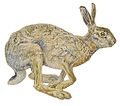Laurasiatheria

Laurasiatheria is a superorder of mammals that originated on the supercontinent Laurasia after it split from the supercontinent Gondwana during the breakup of Pangaea. Laurasiatheria includes a diverse group of mammals, ranging from bats to carnivores, and is distinguished by certain genetic and morphological characteristics. This superorder is one of the major groups within the clade Theria, the subclass of mammals that includes all living placental mammals, marsupials, and their extinct relatives.
Classification[edit]
Laurasiatheria is divided into several orders, which include some of the most well-known and studied mammals. The primary orders within Laurasiatheria are:
- Eulipotyphla – includes small insectivorous mammals like hedgehogs, moles, and shrews.
- Chiroptera – comprises all bats, which are the only mammals capable of true flight.
- Carnivora – includes both feliforms (cats, hyenas, etc.) and caniforms (dogs, bears, etc.), characterized by their carnivorous or omnivorous diets.
- Perissodactyla – odd-toed ungulates, including horses, rhinoceroses, and tapirs.
- Artiodactyla – even-toed ungulates, which includes a wide variety of herbivorous mammals such as deer, cattle, and pigs. This order also includes the Cetacea (whales, dolphins, and porpoises) as a result of molecular studies showing their descent from artiodactyl ancestors.
- Pholidota – consists of the pangolins, unique scaled mammals that feed on ants and termites.
Evolution[edit]
The Laurasiatheria clade is believed to have diverged from the other mammals of the superorder Euarchontoglires around 85 to 95 million years ago, in the Late Cretaceous period. This divergence was part of the broader mammalian radiation that occurred after the extinction of the non-avian dinosaurs, allowing mammals to occupy a wide range of ecological niches and undergo significant diversification. The name "Laurasiatheria" reflects the hypothesis that these mammals originated on the ancient northern supercontinent of Laurasia. Molecular and fossil evidence supports the monophyly of Laurasiatheria, indicating a common ancestor for this diverse group of mammals.
Characteristics[edit]
Members of the Laurasiatheria share certain genetic markers that support their common ancestry. Morphologically, there is a wide variety among the included orders, reflecting the diverse ecological roles they have evolved to fill. From the echolocation of bats to the specialized digestive systems of ruminants in the Artiodactyla, Laurasiatheria demonstrates a wide range of adaptations.
Conservation[edit]
Many species within the Laurasiatheria face threats from habitat loss, hunting, and climate change. Conservation efforts are critical to protect these diverse mammalian groups, with strategies including habitat preservation, legal protection, and breeding programs for endangered species.
See also[edit]

-
Laurasiatheria
-
Laurasiatheria
-
Laurasiatheria
-
Laurasiatheria
-
Laurasiatheria
-
Laurasiatheria
-
Laurasiatheria
Ad. Transform your life with W8MD's Budget GLP-1 injections from $75


W8MD offers a medical weight loss program to lose weight in Philadelphia. Our physician-supervised medical weight loss provides:
- Weight loss injections in NYC (generic and brand names):
- Zepbound / Mounjaro, Wegovy / Ozempic, Saxenda
- Most insurances accepted or discounted self-pay rates. We will obtain insurance prior authorizations if needed.
- Generic GLP1 weight loss injections from $75 for the starting dose.
- Also offer prescription weight loss medications including Phentermine, Qsymia, Diethylpropion, Contrave etc.
NYC weight loss doctor appointmentsNYC weight loss doctor appointments
Start your NYC weight loss journey today at our NYC medical weight loss and Philadelphia medical weight loss clinics.
- Call 718-946-5500 to lose weight in NYC or for medical weight loss in Philadelphia 215-676-2334.
- Tags:NYC medical weight loss, Philadelphia lose weight Zepbound NYC, Budget GLP1 weight loss injections, Wegovy Philadelphia, Wegovy NYC, Philadelphia medical weight loss, Brookly weight loss and Wegovy NYC
|
WikiMD's Wellness Encyclopedia |
| Let Food Be Thy Medicine Medicine Thy Food - Hippocrates |
Medical Disclaimer: WikiMD is not a substitute for professional medical advice. The information on WikiMD is provided as an information resource only, may be incorrect, outdated or misleading, and is not to be used or relied on for any diagnostic or treatment purposes. Please consult your health care provider before making any healthcare decisions or for guidance about a specific medical condition. WikiMD expressly disclaims responsibility, and shall have no liability, for any damages, loss, injury, or liability whatsoever suffered as a result of your reliance on the information contained in this site. By visiting this site you agree to the foregoing terms and conditions, which may from time to time be changed or supplemented by WikiMD. If you do not agree to the foregoing terms and conditions, you should not enter or use this site. See full disclaimer.
Credits:Most images are courtesy of Wikimedia commons, and templates, categories Wikipedia, licensed under CC BY SA or similar.
Translate this page: - East Asian
中文,
日本,
한국어,
South Asian
हिन्दी,
தமிழ்,
తెలుగు,
Urdu,
ಕನ್ನಡ,
Southeast Asian
Indonesian,
Vietnamese,
Thai,
မြန်မာဘာသာ,
বাংলা
European
español,
Deutsch,
français,
Greek,
português do Brasil,
polski,
română,
русский,
Nederlands,
norsk,
svenska,
suomi,
Italian
Middle Eastern & African
عربى,
Turkish,
Persian,
Hebrew,
Afrikaans,
isiZulu,
Kiswahili,
Other
Bulgarian,
Hungarian,
Czech,
Swedish,
മലയാളം,
मराठी,
ਪੰਜਾਬੀ,
ગુજરાતી,
Portuguese,
Ukrainian



